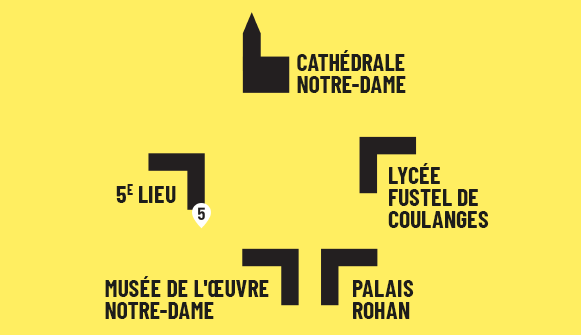Before or after your visit to the 5th Place, you will have free access to various resources and publications relating to architecture and heritage.
OUR PUBLICATIONS
These publications are designed to help you take full advantage of the A Trip through Strasbourg exhibition or to find out more about the city by yourself.
Itineraries
- Grande-Île and Neustadt, UNESCO World Heritage (FR, DE, EN)
- Notre-Dame Cathedral (FR, DE, EN)
- Art in public places (FR, DE, EN)
- Gutenberg and printing (FR, DE, EN)
- The Krutenau district (FR, DE, EN)
- Guilds in Strasbourg (FR, DE, EN)
- Organs (FR, DE, EN)

Monument Tracker is an app which offers itineraries, games (quiz, photo competition, treasure hunt) and activities and guides you towards monuments. It is available in French, English and German, on iOS and Android.
![]()
After you’ve been round the 5th Place, it’s well worth popping in to one or more of the many museums that Strasbourg offers, and find out more about the heritage of Alsace and the Rhine Valley.
There are 4 museums within immediate reach of the 5th Place. The Museum of the Œuvre Notre-Dame features art and sculpture of the Middle Ages and the Renaissance and gives a fascinating picture of the prestigious position Strasbourg held as one of the most important artistic centres of the Holy Roman Empire.
A couple of steps further on, you’ll find the Palais Rohan and its 3 museums. The Archaeological Museum is one of the most important archaeological museums in France and spans the history of the Alsace region. The sumptuous rooms of the Museum of Decorative Arts feature excellent collections of Strasbourg decorative arts, while the Museum of Fine Arts offers an extensive panorama of the history of painting in Europe from its early beginnings through to 1870.
The main feature of the nearby Historical Museum is a marvellous plan-relief of Strasbourg dating back to 1727. The Alsatian Museum takes visitors on a charming trip through homes in Strasbourg through the ages and presents thousands of ancient objects used in rural life in Alsace.
APPLICATION

United Nations Organisation for education, science and culture
Strasbourg, Grande-Île and Neustadt inscribed on the World Heritage List in 1988, extended in 2017
UNESCO World Heritage List: from Grande-Île to Neustadt
Grande-Île, characteristic of Rhineland Europe, and Neustadt, an imperial urban extension built in the 19th century, form a coherent urban environment, with the Cathedral, a masterpiece of Gothic art, as its centrepiece and its many waterways as the thread running through the city. Strasbourg is a city fashioned by its Germanic and French influences, which reflect the major periods of European history.
Grande-Île was inscribed on the World Heritage List in 1988 and Neustadt in 2017.

Strasbourg, City of Art and History
Strasbourg was awarded the official French label of French Towns of Art and History in February 2014, a label which is granted by the Heritage directorate of the French Ministry of culture to local authorities which highlight their heritage. It guarantees the quality of the official guides and of the heritage and architectural activity coordinators. The towns and regions in the scheme set out to showcase the diversity of their heritage, from ancient remains to 21st-century architecture. The network currently comprises 199 towns and regions.
Nearby towns and regions belonging to the scheme include Mulhouse, Sélestat, Pays du Val d’Argent and Pays de la région de Guebwiller

The European Heritage label
The European Heritage label is designed to highlight sites which have played a crucial role in the history, culture and development of the European Union and of Europe itself and to see these sites through a European viewpoint, through information and educational activities. Strasbourg’s European district was granted the label in 2016.

The Remarkable Contemporary Architecture label»
The Remarkable Contemporary Architecture label is granted to buildings and architectural ensembles, engineering works and developments under 100 years old which previously came under the “20th-century Heritage” label, which are not classified as historical monuments and whose design is of a particular architectural or technical interest.
1392 buildings, architectural ensembles, engineering works and developments have so far been granted the label.
Examples in Strasbourg include the Rotterdam housing estate (1951-1953), the Ungemach garden city (1924-1929), the Synagogue of Peace (1958), the Esplanade district (1961-1967), the Grande Percée (Great Breakthrough) (1910-1960), the European Parliament (1999) and the COOP (currently being renovated as part of the Deux-Rives urban development scheme).


